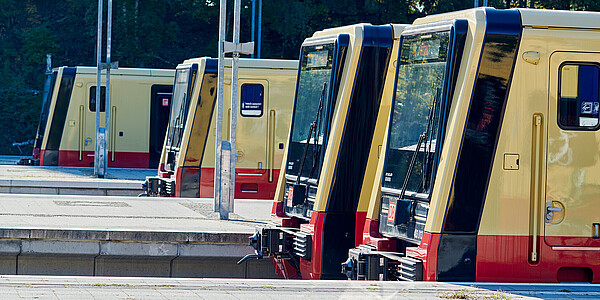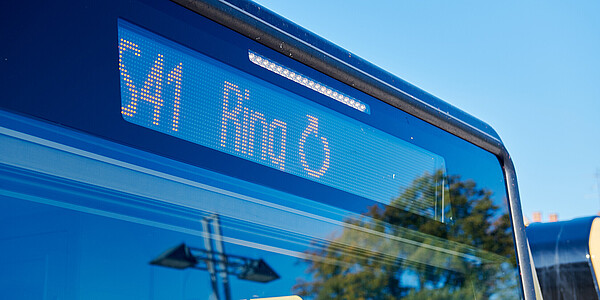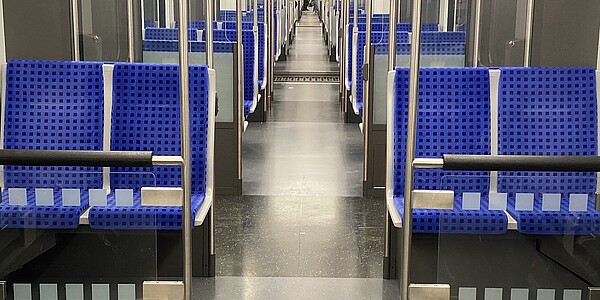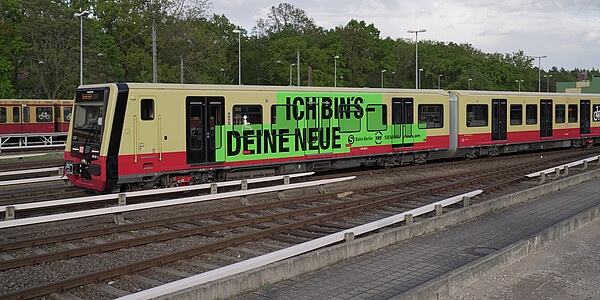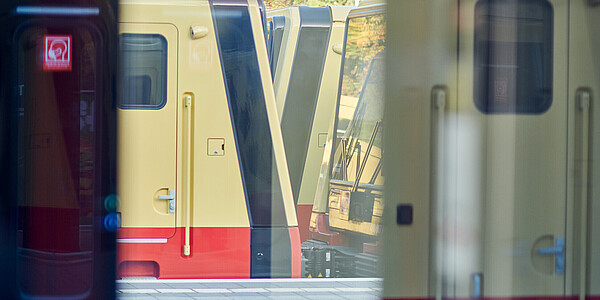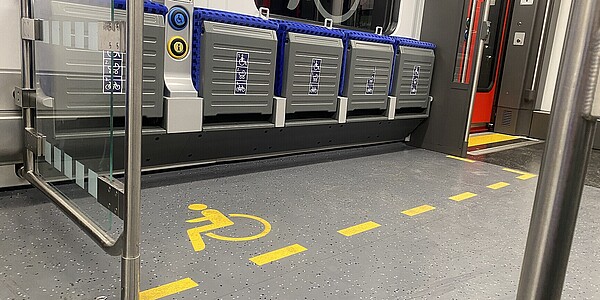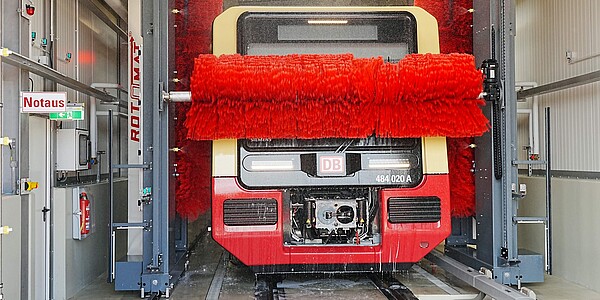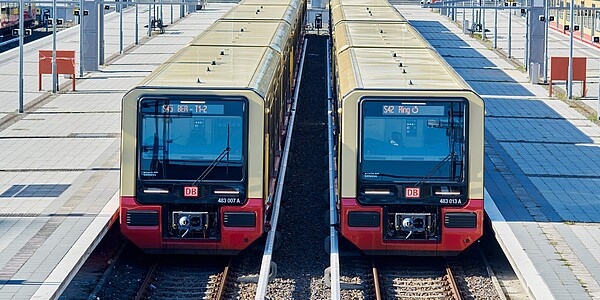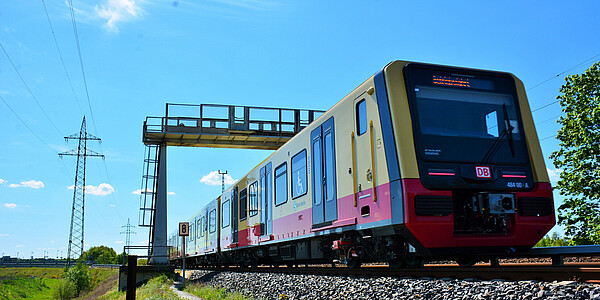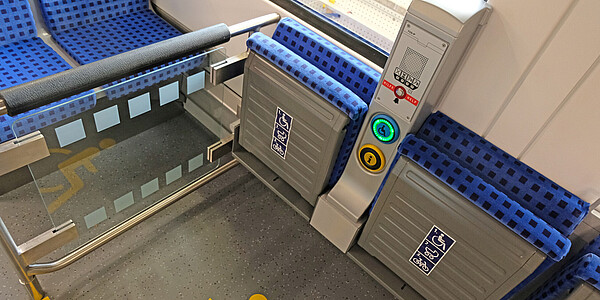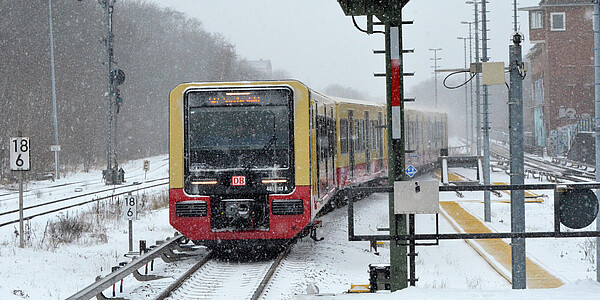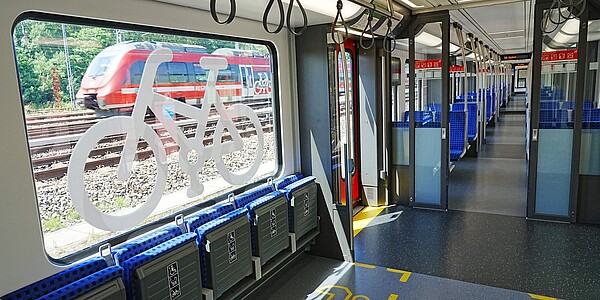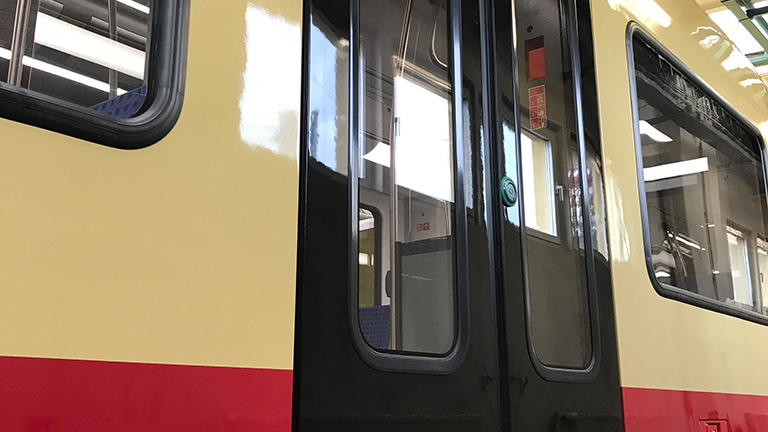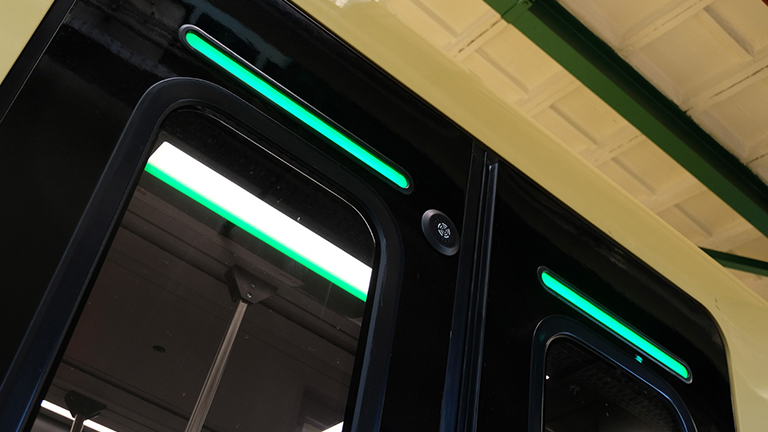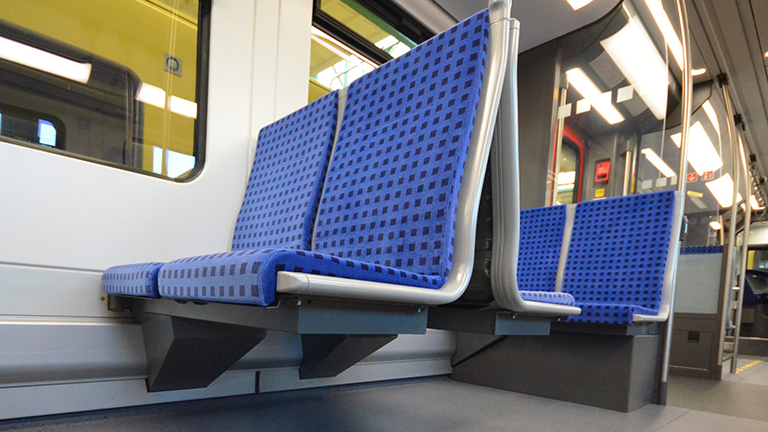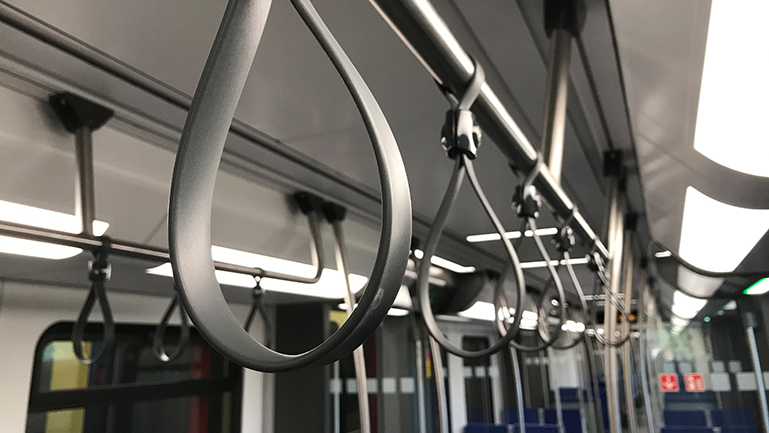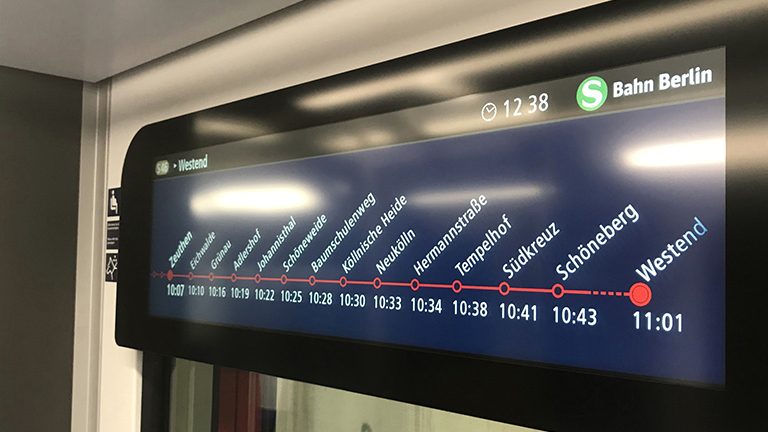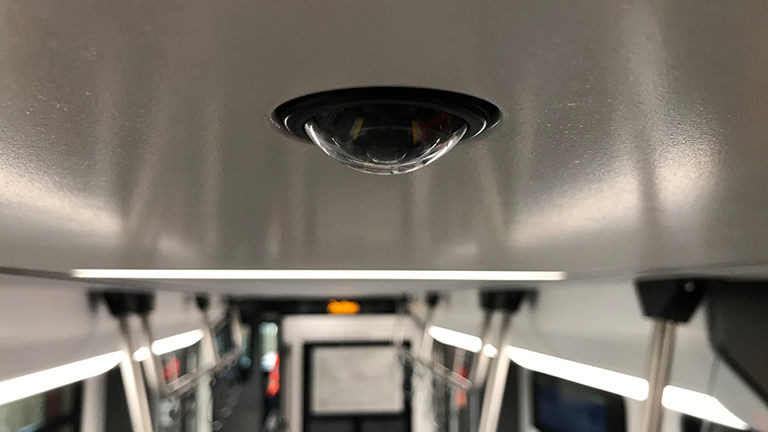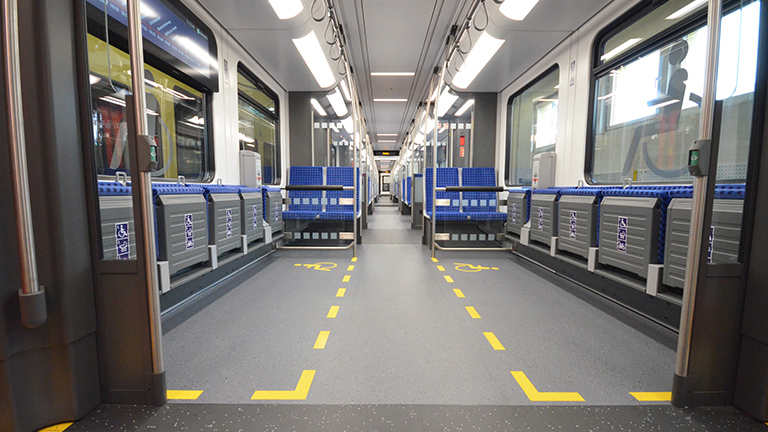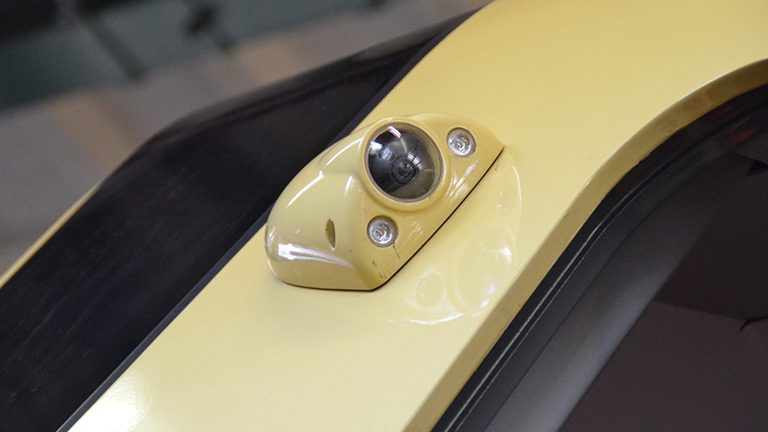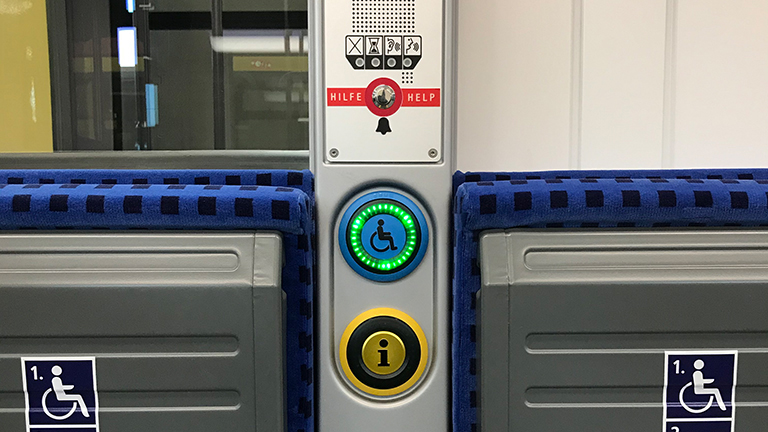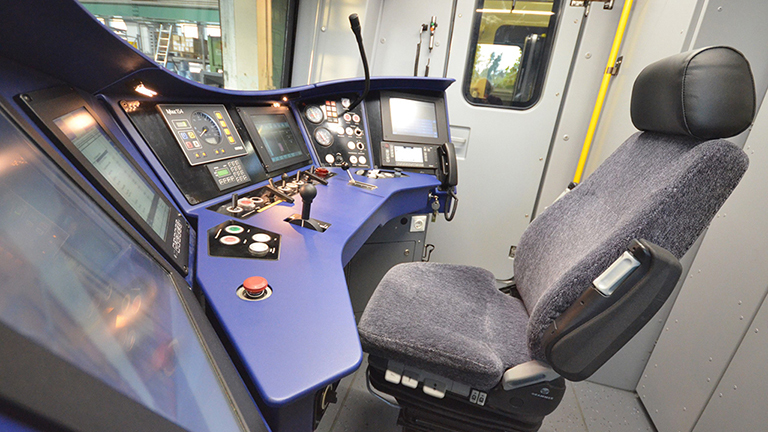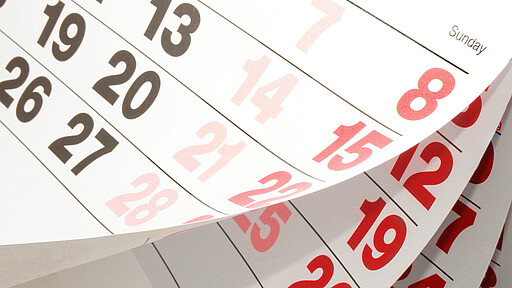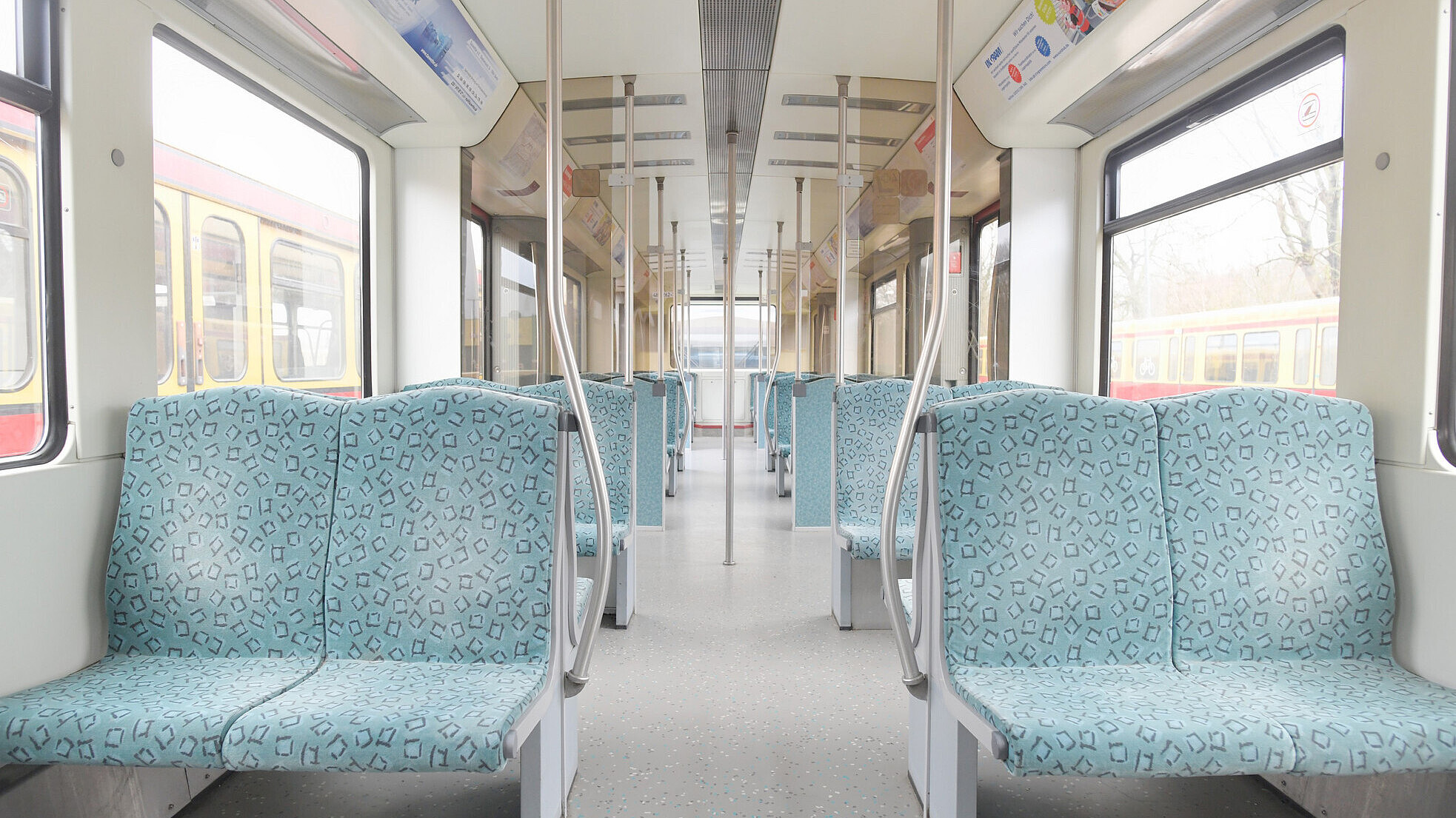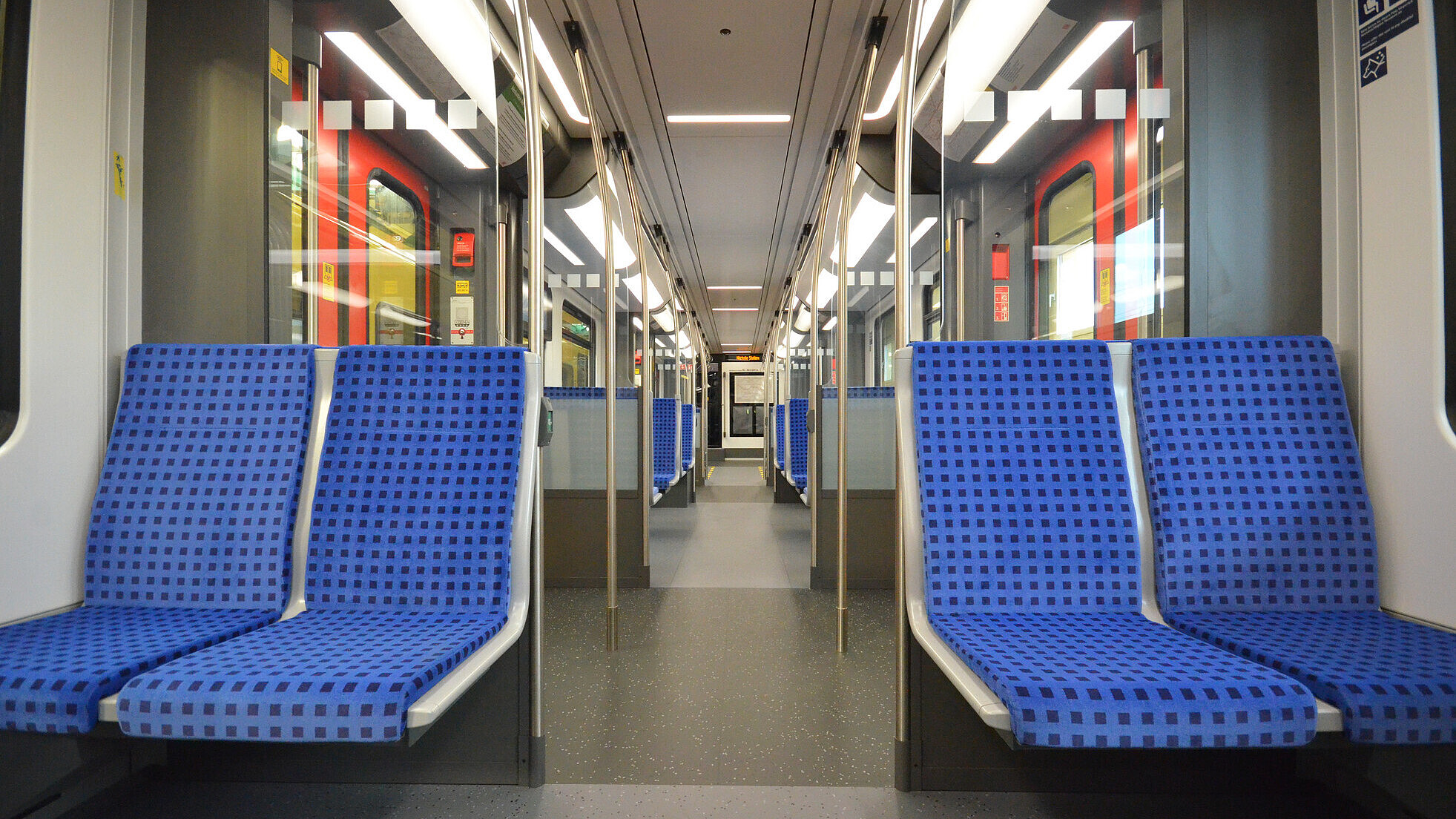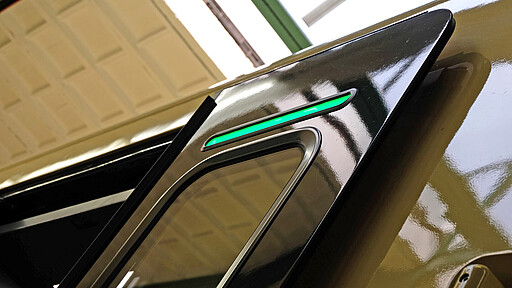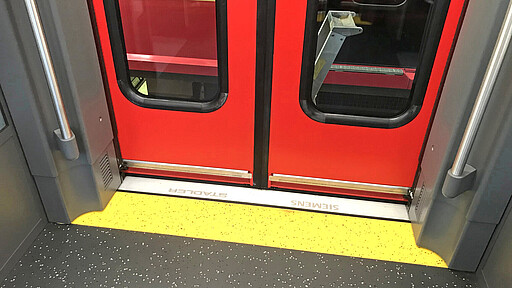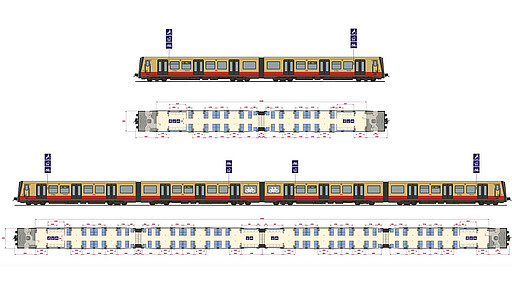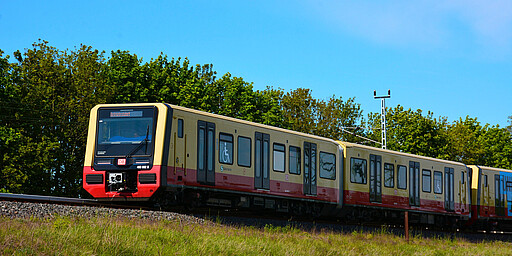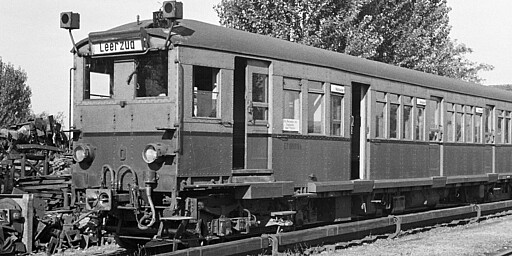Our new S-Bahn
Learn everything there is to know about our 483/484 series.
Berlin's S-Bahn fleet has been significantly rejuvenated in recent years. Since 1 January 2021, the first new S-Bahn trains have been running on the network’s ring/south east segment. Since 18 September 2023, the last new train of 106 is sent onto the tracks.
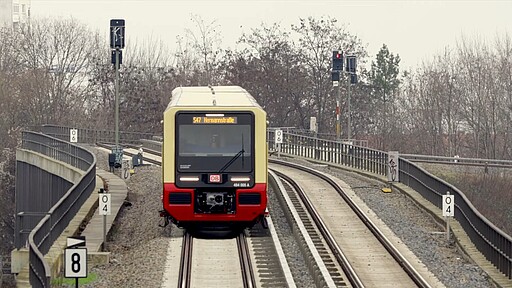
By loading this content, I understand and accept that my user data will be collected and processed by YouTube. For further information, see the data protection regulations .
Production series 483/484: from idea to series model in four minutes!
The brand-new trains offer residents of Berlin and Brandenburg more space, large panoramic windows, air conditioning, CCTV in all carriages, an intercom link to the security control centre, a service column for wheelchair users and state-of-the-art passenger information.

New trains coupled
Two carriages of the new series were ceremonially coupled in Charlottenburg.
- ©
- Deutsche Bahn AG / Hans-Christian Plambeck
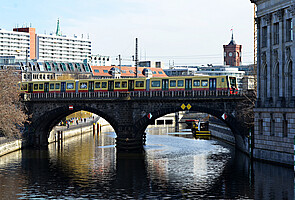
The new S-Bahn
For one brief week in the summer of 2020, the new S-Bahn served as an S3 train on the Stadtbahn route.
- ©
- Jens Wiesner/S-Bahn Berlin
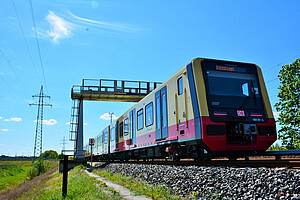
The new S-Bahn
Riding the rails: a 484 series train
- ©
- Kathrin Fiehn/S-Bahn Berlin
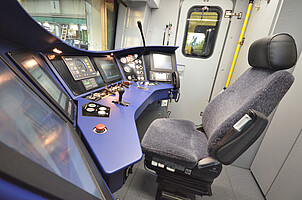
Driver’s cab
The new S-Bahn’s operator cab has undergone a complete overhaul. The redesign supports drivers with more intuitive controls and more real-time information.
- ©
- Jens Wiesner/S-Bahn Berlin
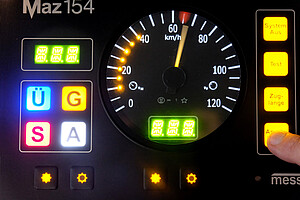
Speed indicator
Speedometer inside the new S-Bahn driver’s cab during a display test
- ©
- Jens Wiesner/S-Bahn Berlin
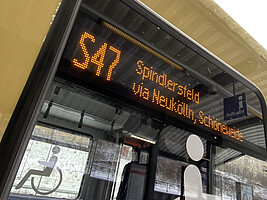
The new S-Bahn
The exterior destination display shows the train’s route, here the S47.
- ©
- Jens Wiesner
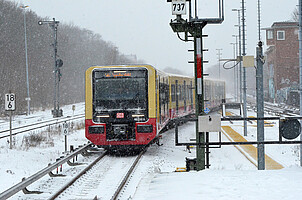
The new S-Bahn
Onset of winter: a new S-Bahn approaching Hermannstraße station
- ©
- Jens Wiesner
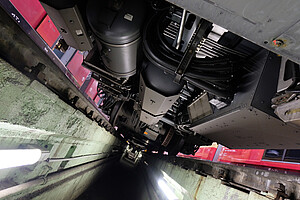
From below
The new S-Bahn at the Schöneweide depot
- ©
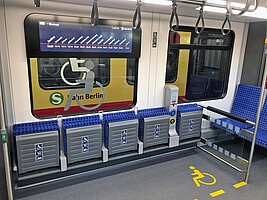
New multi-purpose compartment
Folding seats, interior display, hand straps and support for wheelchair users – the new 483/484 series multi-purpose compartment
- ©
- Jens Wiesner/S-Bahn Berlin
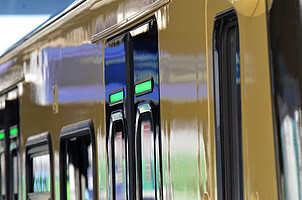
The new S-Bahn
Green door signal: doors are ready to be opened.
- ©
- Jens Wiesner
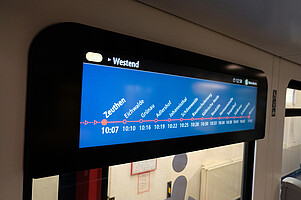
New 483/484 series interior displays
The new side window displays provide improved passenger information.
- ©
- Jens Wiesner/S-Bahn Berlin

Inside the new S-Bahn
Multi-purpose compartment with service unit
- ©
- Jens Wiesner
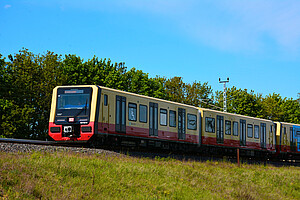
The new S-Bahn
On track: a 483 series train
- ©
- Kathrin Fiehn/S-Bahn Berlin
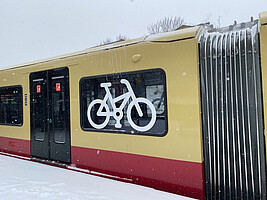
The new S-Bahn
Exterior view: a large bicycle symbol on the window indicates the multi-purpose compartment.
- ©
- Jens Wiesner
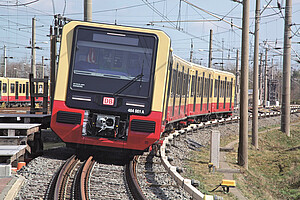
Testing the new S-Bahn
So far, the trains have completed 2,000 of the planned approx. 160,000 test kilometres. Copyright: Konsortium Siemens Mobility and Stadler
- ©
- Konsortium Siemens Mobility und Stadler
Discover all the new features!
Just swipe and click on the + signs to discover the new features.
Area of operation
Over the next few years, our new S-Bahn will commence service on an increasing number of different Ring/Southeast network routes. Find out when and where with this diagram.
The first ten pre-production trains joined our active vehicle fleet on 1 January 2021, serving the S47 route between Spindlersfeld and Hermannstraße. From December 2021 to December 2022, the new S-Bahn ran on the S45 to BER Airport. Since then, the S45 has again been operated by the 481 series.
Since 27 June 2022, further trains have launched on the S46 Königs Wusterhausen – Westend route. More new trains have joined the fleet on the S8 line between Wildau and Hohen Neuendorf (provisionally until Birkenwerder) since 14 October 2022.
The two-stage introduction of the new S-Bahn trains on the S41 and S42 ring route, originally planned between April and October 2023, was already started ahead of schedule on 11 December 2022 and could be completed on 18. September 2023. Since then, all 106 vehicles ordered have been in service on the S-Bahn network on lines S41, S42, S46, S47 and S8.
If necessary, all new vehicles can also be deployed on other lines.
Test your memory
Turn over two cards to find matching pairs. For added fun, you’re not looking for identical images, but pictures of a matching category. Suitable for one or two players.
Romano’s first impressions of the new S-Bahn

- ©
- S-Bahn Berlin
New colour scheme, air con, and emergency call buttons: Romano puts the new 483/484 series to the test – with typical Berlin bluntness. He was delighted by what he found. Are you?
Timeline
When did we order the new S-Bahn production series? When did construction start? And what about testing? Everything you need to know about the 483/484 series’ design, delivery, and production timeline.
Investing in our future
The acquisition was facilitated by the German Länder as part of the Ring Agreement.
Pro tip: signal your stop!
What to do if you’re on a busy train and no green door opener is within easy reach? Just like many buses, the new S-Bahn offers additional buttons throughout the train. You can use these to signal your intent to disembark – once pressed, the doors will open automatically at the next stop.
Service unit inside the new multi-purpose compartment
The service units inside the multi-purpose compartment combine several functions designed for improved communications, especially for wheelchair users.
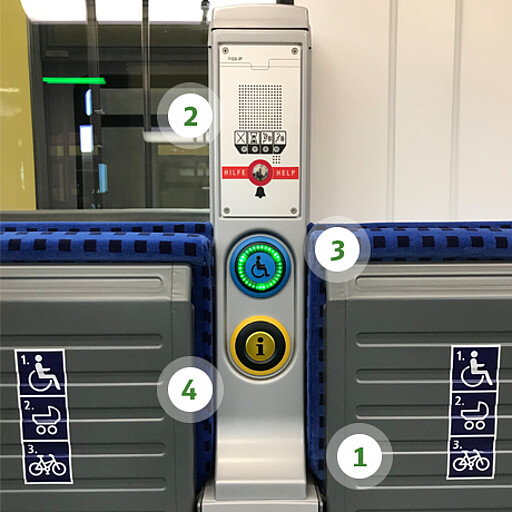
- ©
- Sandra Wiedemann
- Service column: installed between the folding chairs of the multi-purpose compartment for easy wheelchair access
- Intercom:to contact the security control centre and transmit CCTV footage of the carriage in case of emergency
- Blue button:to request wheelchair assistance on exiting the train (wheelchair ramp), also extends door opening times at the front of the train
- Yellow button: to establish voice communications with the S-Bahn service centre in case of questions or to report that the carriage requires cleaning
Technology
How much does our new S-Bahn weigh, what’s ‘under the hood’, and what makes it extra failsafe? Join us for a quick dive into the technical details of our 483/484 series!
Reliable partners
The vehicles are manufactured by a syndicate Siemens and Stadler. These companies have manufacturing facilities in the Berlin-Brandenburg region and guarantee more than 30 years of high operating quality.
What are the differences between the 483 and 484 series?
All in all, the Siemens and Stadler consortium will build 106 new S-Bahn trains, which amounts to 382 new 483/484 series S-Bahn carriages. The 21 483 series quarter trains each consist of two connected, walkthrough carriages, while the 85 484 series half trains comprise four fully connected, walkthrough carriages.
From pre-production models to serial production
The first ten trains (five 483 series two-carriage units and five 484 series four-carriage units) that have been in service since early 2021 are so-called pre-production models. Experience gained from their operations will be factored into the future serial production.
Better safe than sorry
For added redundancy, each quarter train comes with two sets of all drive-related components. Should the drive system fail in one carriage, the other can still power the quarter train to continue the journey.
Each quarter train is equipped with one electromagnetic rail brake, while half trains have two of these. This set-up ensures that, even in unfavourable weather conditions, all trains can brake safely without restrictions like speed reductions.
| Technical specifications | 483 series | 484 series |
|---|---|---|
| Specification: | quarter train | half train |
| Quantity: | 21 | 85 |
| Carriages: | 42 | 340 |
| Manufacturer: | Stadler Pankow, Siemens | Stadler Pankow, Siemens |
| Gauge: | 1435 mm | 1435 mm |
| Coupling length: | 36800 mm | 73600 mm |
| Empty weight: | 68,9 t | 133,6 t |
| Vehicle width: | 3140 mm | 3140 mm |
| Vehicle height: | 3600 mm | 3600 mm |
| Floor height: | 1000 mm (continuous) | 1000 mm (continuous) |
| Entryways per side: | 6 doors at 1300 mm | 12 doors at 1300 mm |
| Longitudinal compressive force: | 800 kN | 800 kN |
| Seats (of which folding seats): | 82 (20) | 190 (40) |
| Standing capacity: | 208 | 438 |
| Bogie axle base distance: | 2100 mm | 2100 mm |
| Driving wheel diameter: | 820 mm | 820 mm |
| Impeller diameter: | 820 mm | 820 mm |
| Maximum speed: | 100 km/h | 100 km/h |
| Maximum acceleration: | 1,0 m/s² | 1,0 m/s² |
| Performance: | 6 x 140 kW | 12 x 140 kW |
| Supply voltage: | 750 V DC (lateral busbar) | 750 V DC (lateral busbar) |
| Starting tractive effort: | 104 kN | 208 kN |

